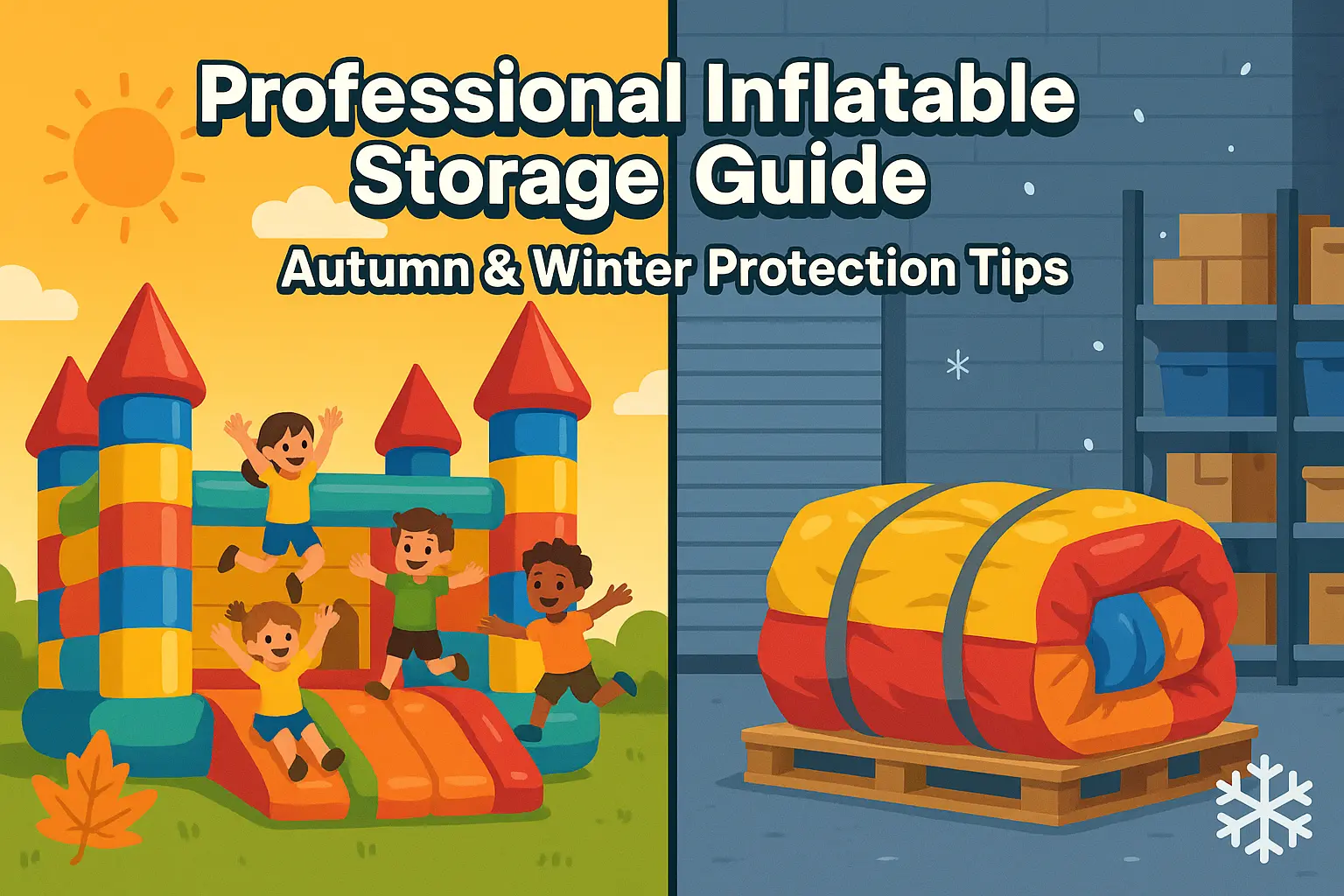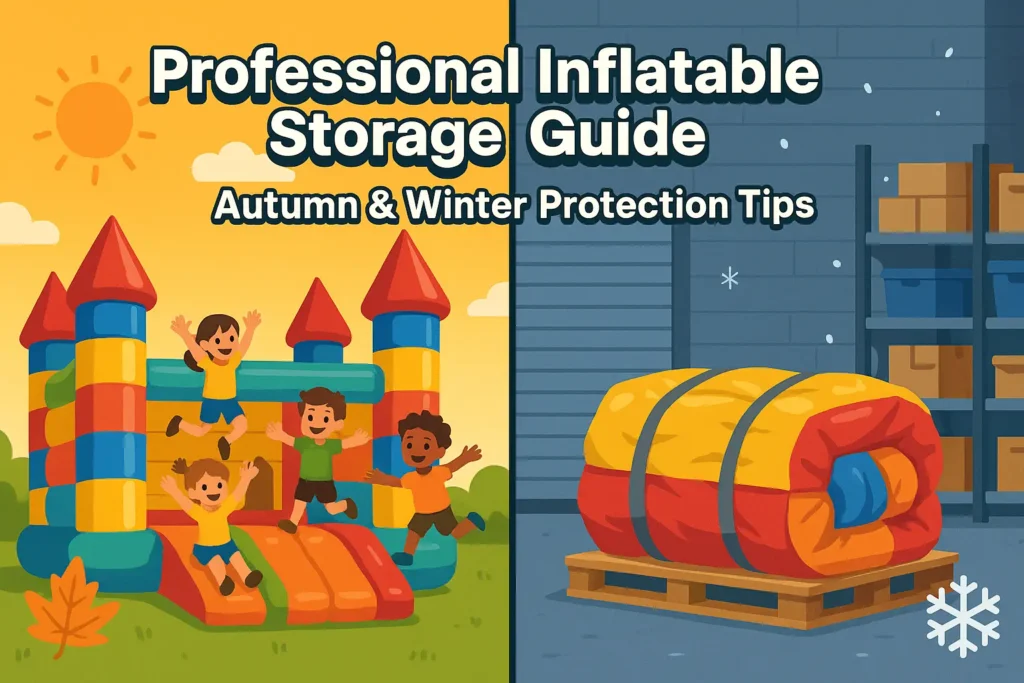As autumn leaves begin to fall and temperatures drop, it’s time to think about properly storing your inflatable products for the off-season. Whether you operate a customized inflatable factory or own commercial inflatables for events and entertainment, proper storage is crucial for maintaining product quality and extending lifespan.
At our inflatable manufacturing facility, we’ve helped countless customers preserve their investments through proper seasonal maintenance. This comprehensive guide will walk you through the professional steps needed to ensure your inflatables remain in pristine condition throughout autumn and winter, ready to bounce back into action when warmer weather returns.
Why Proper Storage Matters
Inflatable products face unique challenges during colder months. Temperature fluctuations, moisture buildup, and extended periods of inactivity can lead to:
- Mold and mildew growth
- Material deterioration and cracking
- Color fading and surface damage
- Unpleasant odors
- Shortened product lifespan
Following our factory-tested storage protocol can prevent these issues and save you significant replacement costs.
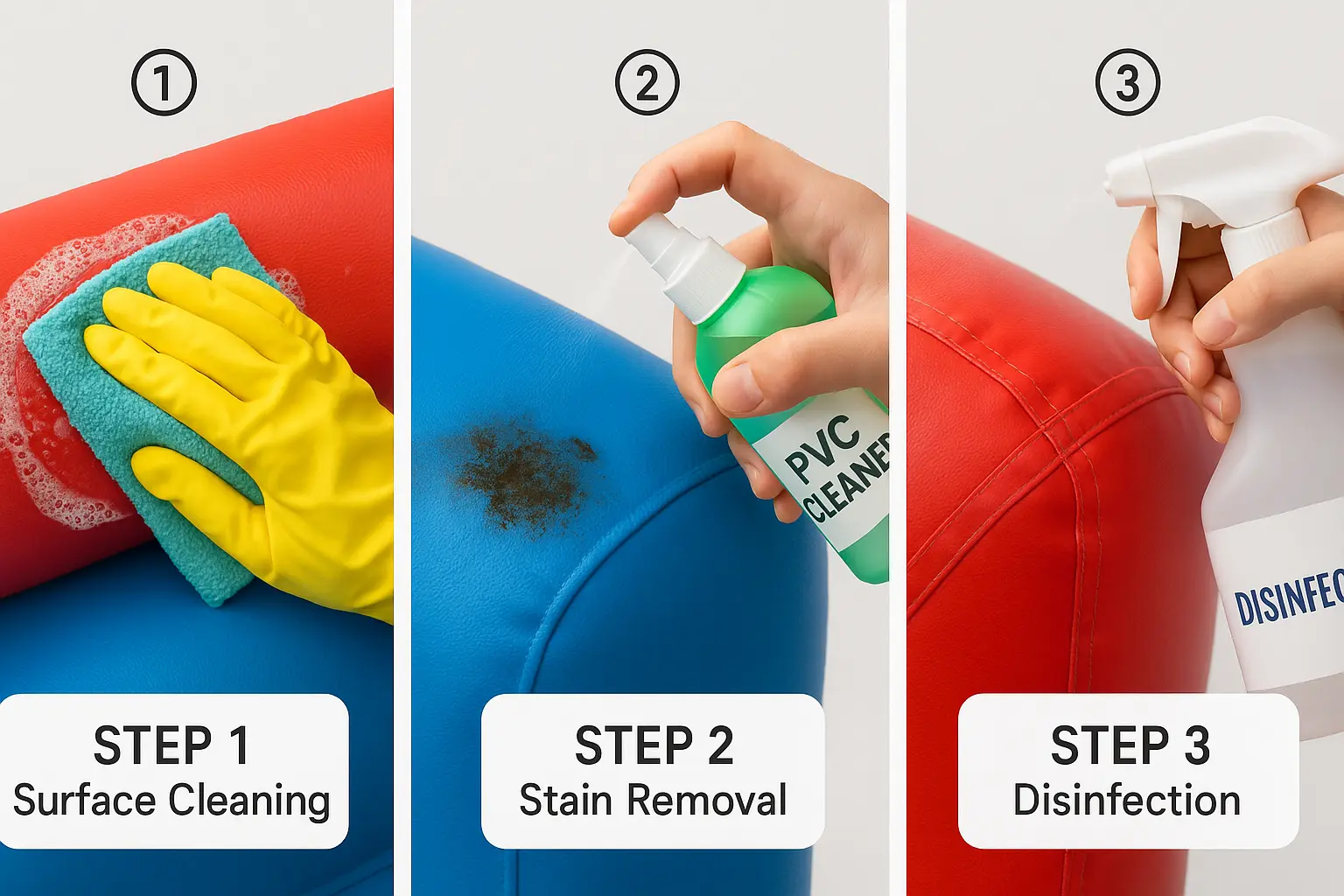
Step 1: Thorough Cleaning and Disinfection
Never store a dirty inflatable. Contaminants left on the surface can cause permanent staining and material breakdown over time.
Surface Cleaning Process
Begin by deflating your inflatable completely. Using a soft cloth or sponge dampened with neutral soapy water or mild detergent, gently wipe down the entire surface. Pay special attention to high-traffic areas where dirt, grass stains, and body oils tend to accumulate.
Work in sections, rinsing your cloth frequently to avoid spreading dirt. For best results, clean on a mild, dry day when you can work outdoors or in a spacious area.
Tackling Stubborn Stains
For persistent stains that won’t budge with regular cleaning, apply a dedicated PVC cleaner specifically formulated for inflatable materials. Important: Avoid harsh chemicals including:
- Acidic or alkaline cleaners
- Solvents like alcohol or gasoline
- Bleach or chlorine-based products
- Abrasive scrubbing pads
These substances can compromise the material’s integrity, causing discoloration, brittleness, or seal failures. Always test any cleaning product on a small, inconspicuous area first.
Disinfection: Your Defense Against Mold
This often-overlooked step is critical for long-term storage success. Spray a diluted PVC-friendly disinfectant across the entire surface, concentrating on seams, folds, and any areas that trap moisture. This prevents mold, mildew, and bacterial growth during the dormant months.
Look for disinfectants labeled as safe for vinyl or PVC materials, and follow the manufacturer’s dilution instructions carefully.
Step 2: Complete Drying – The Most Critical Step
This cannot be overstated: Moisture is the enemy of stored inflatables. Even trace amounts can trigger mold growth, create musty odors, and damage bonded seams.
External Drying
After cleaning and disinfecting, use clean, absorbent towels to pat down all surfaces. Then move the inflatable to a well-ventilated, shaded indoor area for air drying. Direct sunlight may seem like a quick drying solution, but UV rays can degrade PVC materials over time.
Open windows or use fans to promote air circulation. Depending on size and humidity levels, external drying may take several hours.
Internal Drying: The Often-Forgotten Step
Here’s where many storage attempts fail. The interior chambers of your inflatable also collect moisture during use and cleaning. To dry the inside properly:
- Connect a clean, dry blower to the air inlet
- Run it continuously for 30-60 minutes minimum
- For larger inflatables, extend this time to 90 minutes or more
- Periodically feel the air coming out—it should be completely dry
Consider this your insurance policy against mold. The time invested here pays dividends in product longevity.
Verification
Before moving to the next step, verify complete dryness by:
- Running your hand across all surfaces (should feel completely dry, not cool or damp)
- Checking inside air chambers (no moisture droplets visible)
- Ensuring seams and folds are thoroughly dry
If in doubt, give it another hour of drying time.
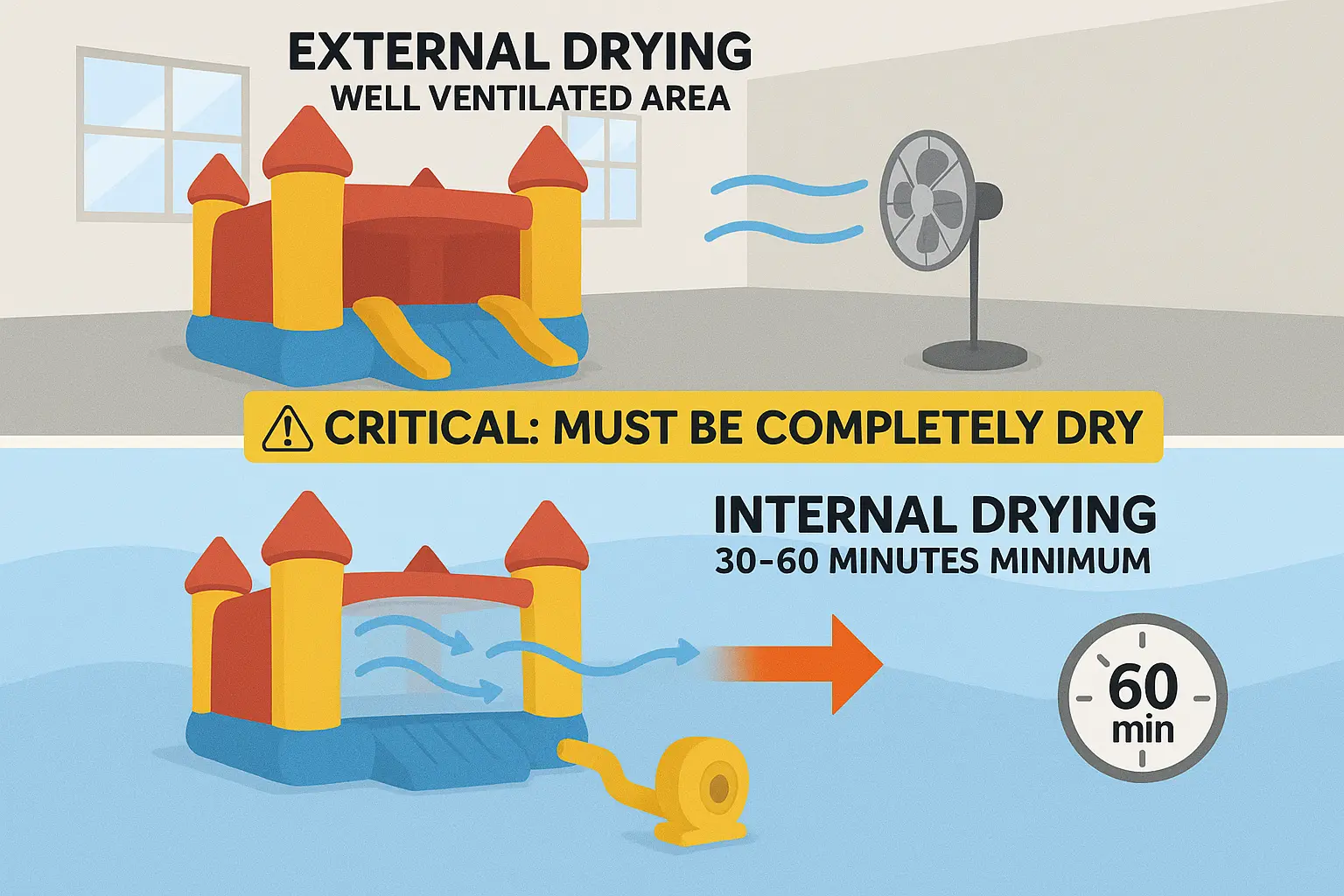
Step 3: Maintenance and Protection
Once your inflatable is bone-dry, it’s time to add a protective layer against the rigors of storage.
Applying Protective Spray
Specialized PVC/vinyl protectants create a barrier that:
- Prevents material aging and oxidation
- Reduces hardening and cracking
- Repels dust and light moisture
- Maintains material flexibility
Apply an even, light coating across all surfaces following the product instructions. Don’t oversaturate—a thin, uniform layer is more effective than heavy application. Allow the protectant to dry completely before proceeding to packing (typically 20-30 minutes).
This step is particularly important for inflatables stored in areas with temperature fluctuations or less-than-ideal humidity control.
Step 4: Careful Packing
How you pack your inflatable directly impacts how it emerges from storage.
The Folding and Rolling Technique
Avoid tight, sharp folds. These create stress points where material can crack or weaken over time. Instead:
- Lay the inflatable on a clean surface
- Fold it loosely into manageable sections
- Smooth out any wrinkles as you work
- Roll gently from one end to the other
- Keep the roll relatively loose—don’t compress tightly
Think of folding a sleeping bag rather than a suitcase. The goal is compact storage without material stress.
Securing the Package
If you’ve retained the original storage bag, use it—these are designed with proper ventilation and sizing. If not available, secure the rolled inflatable with soft straps (avoid using rope, which can create pressure points). Position straps at regular intervals without over-tightening.
Step 5: Professional Warehousing Techniques
Storage conditions make or break your preservation efforts. Here’s how professionals at our customized inflatable factory prepare products for long-term storage.
The Covering Strategy
Use a breathable PVC dust-proof tarpaulin to cover your packed inflatable. Breathable materials allow any minimal moisture to escape, preventing condensation—a common problem with standard plastic sheeting.
Pro tip: If you don’t have a specialized tarp, repurpose the original packaging bag by cutting it open and wrapping it around the rolled inflatable. This provides familiar material contact and some protection.
Elevate with Plastic Pallets
Never store inflatables directly on the floor. Ground-level storage exposes products to:
- Floor moisture and potential water damage
- Pest access (rodents and insects)
- Temperature extremes
- Dust and debris accumulation
Place covered inflatables on plastic pallets (preferable to wood, which can harbor moisture and pests). Ensure the pallet surface is smooth or add a PVC sheet layer to prevent any surface abrasion.
This elevation creates airflow underneath, regulates temperature, and provides a clean barrier from ground-level hazards.
Optimal Warehouse Conditions
Your storage environment should meet these specifications:
Temperature: Maintain between 10°C and 25°C (50°F to 77°F)
- Avoid areas near heating systems or radiators
- Keep away from uninsulated walls that experience temperature swings
Humidity: Keep below 65% relative humidity
- Consider a dehumidifier in naturally humid spaces
- Monitor with a simple hygrometer (available inexpensively)
Light: Protect from direct sunlight
- UV exposure degrades PVC materials progressively
- Choose interior spaces without large windows, or use UV-blocking window film
Ventilation: Ensure good air circulation
- Prevents moisture buildup and stagnant air
- Reduces musty odors
- Helps maintain consistent temperature
Pest Control Protocols
Conduct monthly inspections of your storage area:
- Check for signs of rodent activity (droppings, gnaw marks)
- Look for insect presence or damage
- Ensure no gaps or entry points for pests
- Consider pet-safe rodent deterrents if needed
Rodents find inflatable materials attractive for nesting. A single breach can cause extensive damage requiring professional repair or replacement.
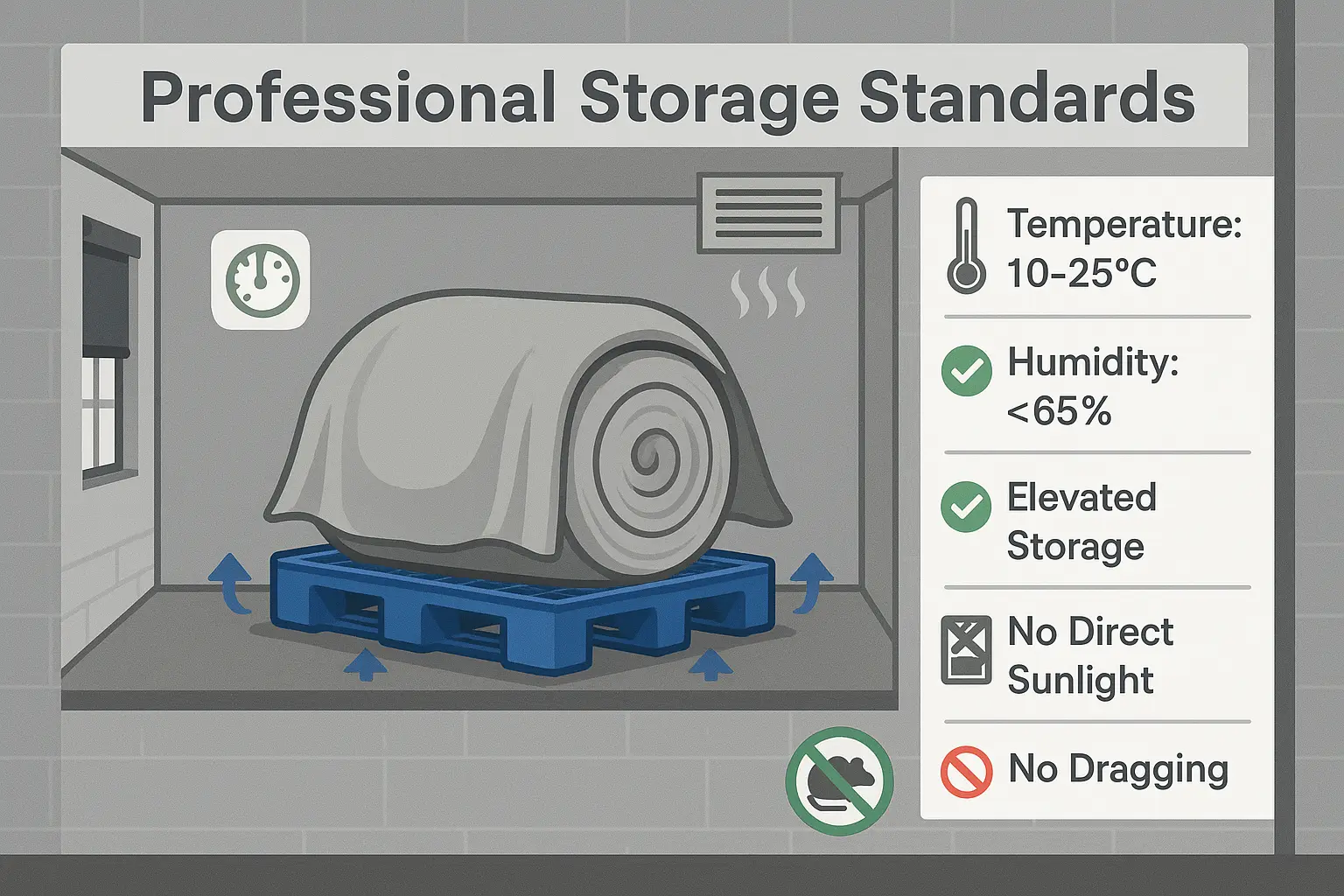
Critical Handling Rule Throughout All Stages
Never drag an inflatable product—packed or unpacked—across any surface. Always lift and carry, even short distances. Dragging causes:
- Surface abrasion and scratching
- Seam stress and potential tears
- Dirt and debris adhesion
- Premature wear patterns
For larger inflatables, use adequate personnel or material handling equipment to avoid dragging temptation.
Pre-Season Reactivation Checklist
When warmer weather returns and it’s time to bring your inflatable out of hibernation:
- Inspect before inflating – Check for any signs of damage, mold, or pest activity
- Clean lightly – Wipe down with a damp cloth to remove storage dust
- Test inflate gradually – Allow material to warm to ambient temperature first
- Check all seams and valves – Ensure integrity before full use
- Sanitize again – Quick disinfectant spray before public or commercial use
Investment Protection That Pays Off
Following this professional storage protocol may seem time-intensive initially, but consider the mathematics:
- Proper storage can extend inflatable lifespan by 3-5 years or more
- Replacement costs for commercial inflatables range from hundreds to thousands of dollars
- Time spent on correct storage: 2-4 hours annually
- Time and cost of replacing neglected inflatables: significant
The storage investment returns multiples through:
- Extended product life
- Maintained appearance and functionality
- Reduced repair needs
- Better customer experience when you use quality-maintained equipment
Why These Steps Matter: Insights from Manufacturing
At our customized inflatable factory, we engineer products for durability, but materials science has limits. PVC and vinyl materials respond to environmental conditions:
- Cold temperatures cause material contraction and brittleness
- Heat exposure leads to expansion and accelerated aging
- Moisture presence triggers mold, mildew, and adhesive breakdown
- UV radiation breaks down polymer chains, causing fading and cracking
By controlling these variables during storage, you maintain the material properties we build into every product during manufacturing.
Summary: Your Inflatable Care Commitment
Protecting your inflatable investment through autumn and winter requires attention to detail but rewards you with years of reliable performance. Remember the essential steps:
- ✓ Clean thoroughly – Remove all contaminants
- ✓ Disinfect completely – Prevent biological growth
- ✓ Dry exhaustively – Eliminate all moisture (inside and out)
- ✓ Protect adequately – Apply PVC protectant spray
- ✓ Pack carefully – Fold loosely, roll gently
- ✓ Store professionally – Elevate, cover, control environment
- ✓ Inspect regularly – Monthly checks for issues
Partner with Quality from the Start
While proper storage extends inflatable life significantly, starting with quality manufacturing makes the biggest difference. Products from our customized inflatable factory are engineered with:
- Premium PVC materials resistant to weathering
- Reinforced seams designed for longevity
- UV-resistant coatings where applicable
- Quality control testing before shipment
Combined with the storage practices outlined in this guide, you’re ensuring maximum return on your inflatable investment.
Have questions about storing specific inflatable types or need custom solutions? Contact our team at the customized inflatable factory for personalized guidance. We’re committed to helping you maintain the quality and performance of your inflatable products season after season.
Thank you for choosing quality inflatables and for taking the time to care for them properly. Here’s to many more seasons of fun, function, and profit from your well-maintained inflatable investments!

